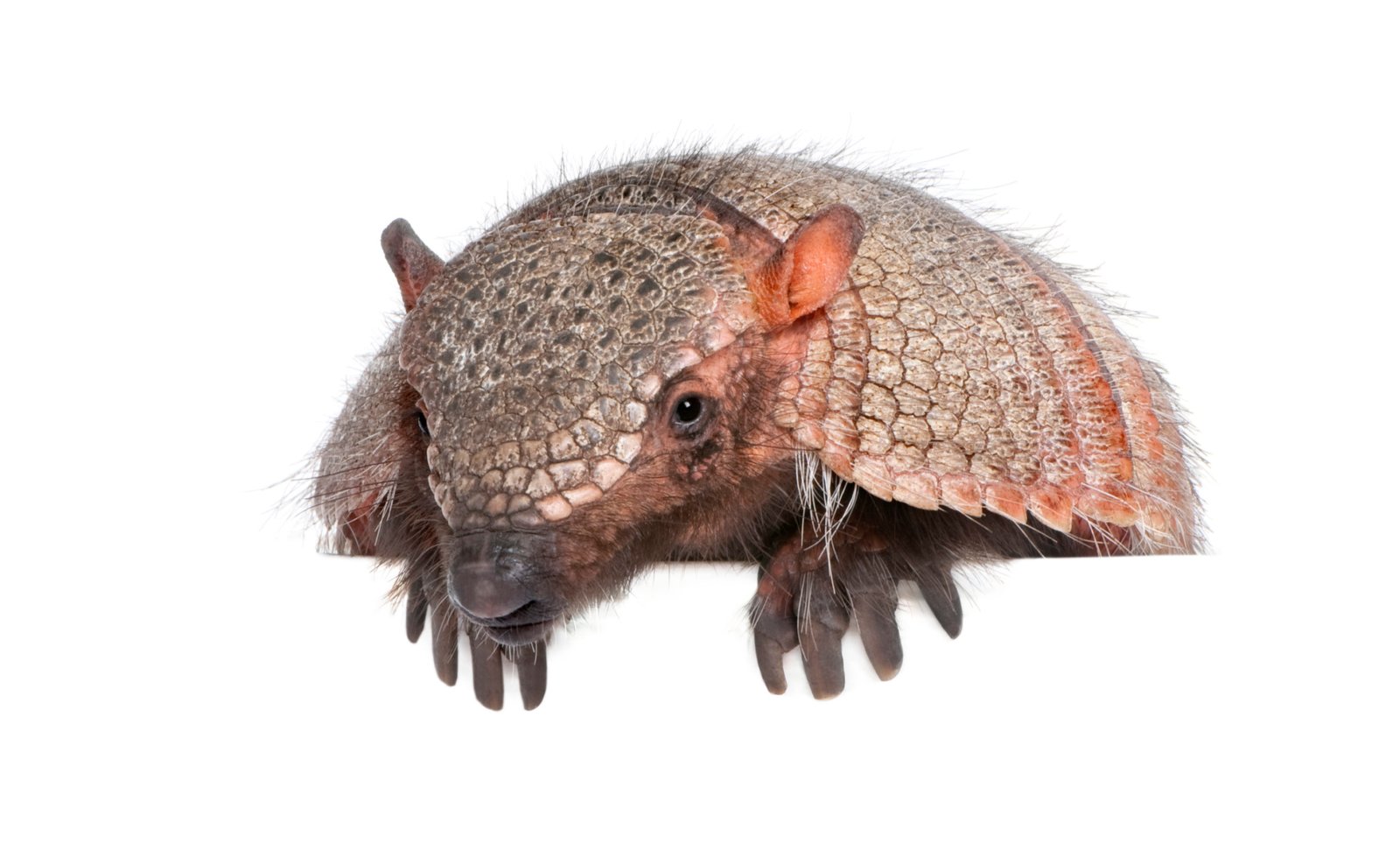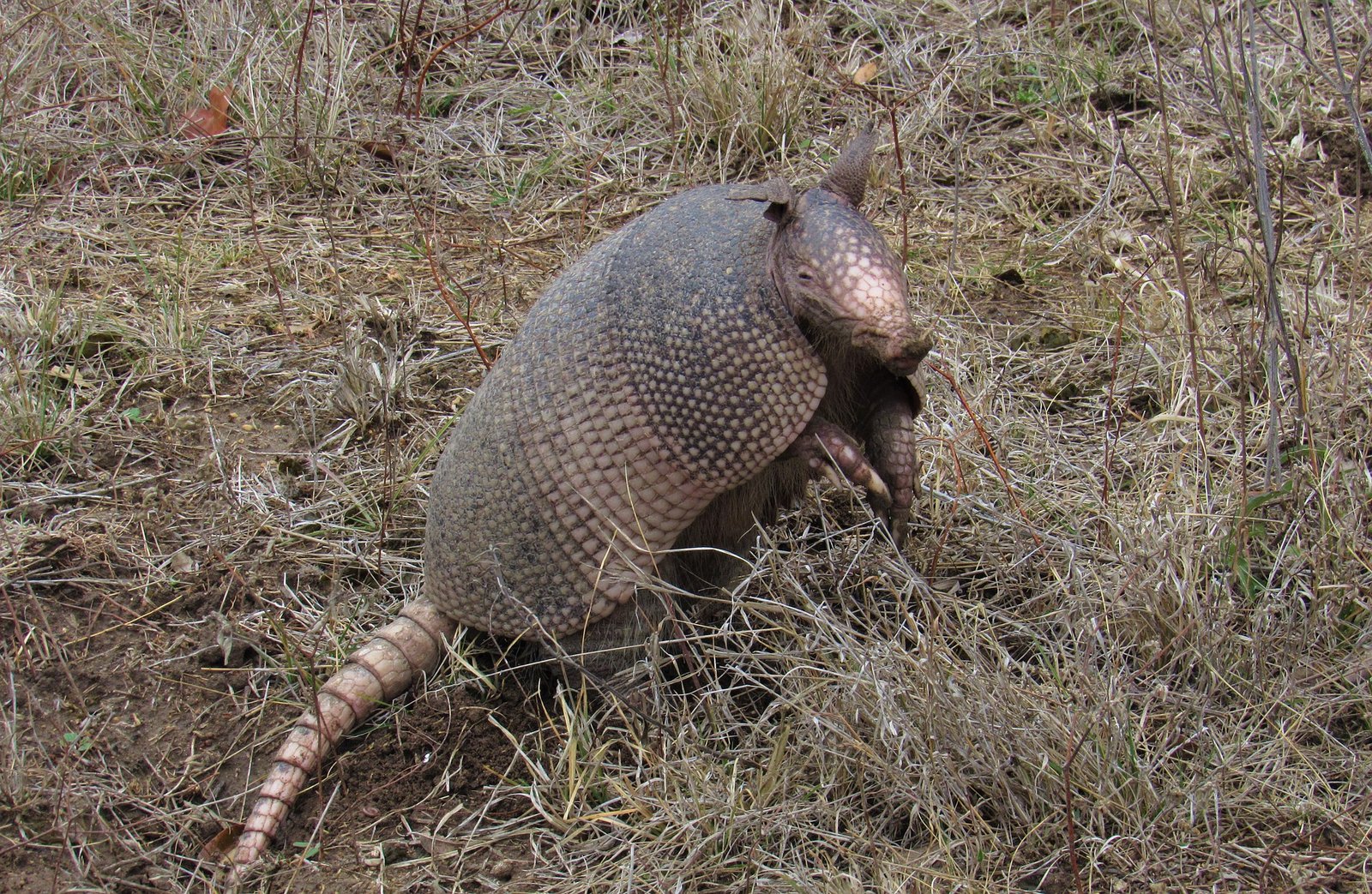Armadillos Of North America

Description Of The Armadillo
There are 21 armadillo species, and some armadillos are very small, while others are very large. The pink fairy armadillo, which is about 6 inches long, is the smallest. The biggest species are giant armadillos, and they are about 5 feet long.
An armadillo’s armor consists of overlapping plates that cover the back, the head, the legs, and the tail. The number of armored bands identifies the various species. Only one species can roll itself into a hard armored ball to defend itself against predators, the three-banded armadillo. Other armadillo species simply dig a hole quickly and hunker down so that their tender stomach is protected, and the only thing visible is their armor.
Armadillos have pointy snouts and long sticky tongues that are similar to anteaters. Their eyesight is poor, so they hunt with a sense of smell that is highly developed. They also have wiry hairs along their sides and belly, which, like curb feelers on some cars, they use to feel their way around. Armadillos are equipped with strong legs and sharp claws designed for digging. 1Go To Source livescience.com -“Armadillo Facts”
Learn More: Damaging Causing Wildlife
Armadillo Body Armor
The armadillo’s hard shell, called a carapace (same term used for turtle shells), is made of bone and a tough coating of tissue.
In its shell lies the key to the armadillo’s defense mechanism. The protein keratin composes about 2,000 tiny scales, or scutes, and makes up the carapace. The carapace is subdivided over its forequarters into the anterior scapular shield and its hindquarters into the posterior pelvic shield.
This animal is also built with a series of bands between its two shield plates, and the number of bands depends on the armadillo species. These softer bands resemble an accordion and enable mobility. In most armadillos, on all sides, the two shields are connected to the skin. 2Go To Source animals.howstuffworks.com -“How do armadillos roll into a ball?”
Common Armadillo Behavior

The armadillo is constructed to be a phenomenal digger. Its shovel-like front paws and strong claws are useful instruments for digging the burrows in which the animals live and reproduce.
One armadillo may dig multiple burrows. Armadillo burrows that their original owner has abandoned often become homes for reptiles or other mammals.
The armadillo may look heavy, but they are exceptional swimmers. Either by swimming or sinking to the bottom and walking underwater, the species can cross streams. The animal is capable of holding its breath for up to six minutes, perhaps an adaptation for soil foraging.
The species doesn’t form long-term pairs or social groups. An armadillo may never interact with another armadillo after reaching adulthood outside of the breeding season, which occurs during the summer.
The nine-banded masculine armadillos are territorial. They battle to stop other males from entering their territory during the breeding season so that they can mate exclusively with any females who live there.
Once a territory has been created, an individual male may mate with as many as three females. Females, on the other hand, may travel to mate with more than one male between territories. 3Go To Source activewild.com -“Nine-Banded Armadillo Facts, Pictures & In-Depth Information”
Armadillo Reproduction Cycle
The female Armadillo’s gestation period can last anywhere between 60-120 days, depending on the species. Delayed implantation occurs in certain species, such as the Nine-banded Armadillo, whereby the young are not born until 8 months after mating occurs. It helps their capacity to colonize new regions.
Female Armadillos will give birth to identical infants of the same sex that no other animal is known to have. All 4 infants develop and share the same placenta from the same egg. Infant Armadillos have no armor but a soft leathery skin that hardens as it grows.
At around 10 weeks, infants are weaned. At between 3 and 12 months, Armadillos reach sexual maturity. An Armadillo’s life span is around 15 years in captivity. 4Go To Source animalcorner.org -“Armadillo”
Habitat Of Armadillos
In forested areas and grasslands, armadillos prefer warm, moist climates and thrive. They usually gravitate towards areas with loose, porous soil because they have to dig for their food and shelter.
These animals use their strong claws throughout their home range to dig several burrows in which to live and seek refuge from extreme weather or predators. An armadillo’s burrow is typically 15 feet deep and 8 inches wide.
Armadillo Range

Armadillos are distributed strictly in the New World, ranging from North America (Missouri) to Central/ South America. Armadillo species have been recorded as far south as Cape Horn in South America.
The nine-banded armadillos have the northernmost distribution. Originally, their range extended from South America to Mexico but steadily expanded northward to the Southern United States. At present, their range extends throughout the Midwest, and nine-banded armadillos have recently been discovered as far north as Nebraska. Scientists speculate that global climate change and natural predators’ loss could contribute to this typically more neotropical species’ northward expansion. 5Go To Source animaldiversity.org -“Dasypodidae armadillos”
Diet Of Armadillos
Each armadillo species has a different diet, and animals in different areas rely on very different food sources for some species. The vast majority of armadillos, however, are insectivores. They primarily rely on ants, termites, grubs, and other insects to make up their diets.
Worms, frogs, lizards, eggs, and some carrion are other food sources. Some species eat only a few different types of foods and have highly specialized diets, while others will eat a wide variety of insects and small creatures. 6Go To Source animals.net -“Armadillo”
Threats To Armadillo Species
Many armadillo species are threatened or endangered. Many of the problems armadillos face are human encroachment, slash-and-burn farming, hunting, and death by domestic dogs. Of the twenty armadillo species, only one appears to be increasing in number, the nine-banded armadillo.
The nine-banded armadillo has expanded its home range northward into the United States in the last hundred years or so. Even farther north, Armadillos have moved as far west as Colorado and as far north as Illinois. As they can not tolerate even relatively short periods of extreme cold, cold weather will eventually stop the armadillo spread because they do not have large fat reserves to help insulate their bodies. 7Go To Source armadillo-online.org -“What’s an armadillo?
Armadillo Carried Disease
It is known that the bacteria that cause leprosy, a chronic illness that can lead to disfigurement and nerve damage, are transmitted from nine-banded armadillos to humans.
In the southern United States, the transmission of Mycobacterium leprae (leprosy) from armadillos to humans has been shown to occur. However, these animals also live in the Brazilian Amazon, where, as a dietary source of protein, some residents hunt and kill armadillos. Whether these animals act as a natural reservoir for leprosy transmission in Brazil has not been proven before. 8Go To Source sciencedaily.com -“More than half of Amazonian armadillos carry leprosy”
Armadillo Species Of North America
- Nine Banned Armadillo Dasypus novemcinctus
- Naked Tail Armadillo Cabassous centralis
Sources:
- Bradford, Alina. “Armadillo Facts.” Livescience.Com, Future US, 6 Oct. 2015, www.livescience.com/52390-armadillos.html#:%7E:text=Habits,evenings%2C%20they%20forage%20for%20food.
- Conger, Cristen. “How Do Armadillos Roll into a Ball?” HowStuffWorks, 7 May 2020, animals.howstuffworks.com/mammals/armadillo-ball1.htm.
- Admin. “Nine-Banded Armadillo Facts, Pictures & In-Depth Information.” Active Wild, ActiveWild.com, 25 Nov. 2020, www.activewild.com/nine-banded-armadillo/#nine-banded-armadillo-predators.
- “Armadillo.” Animal Corner, Animal Corner, animalcorner.org/animals/armadillo. Accessed 28 Jan. 2021.
- Capizzo, A.; E. Moses; E. Shirley and P. Myers 2013. “Dasypodidae” (On-line), Animal Diversity Web. Accessed January 28, 2021 at https://animaldiversity.org/accounts/Dasypodidae/
- Oldham, Cydni. “Armadillo.” Animals Network, Animals.NET, 3 Apr. 2019, animals.net/armadillo.
- Nixon, Joshua. “A Little About Armadillos.” Armadillo Online, armadillo-online.org/armadillos.html. Accessed 28 Jan. 2021.
- PLOS. “More than half of Amazonian armadillos carry leprosy.” ScienceDaily. ScienceDaily, 28 June 2018. <www.sciencedaily.com/releases/2018/06/180628151918.htm>.
